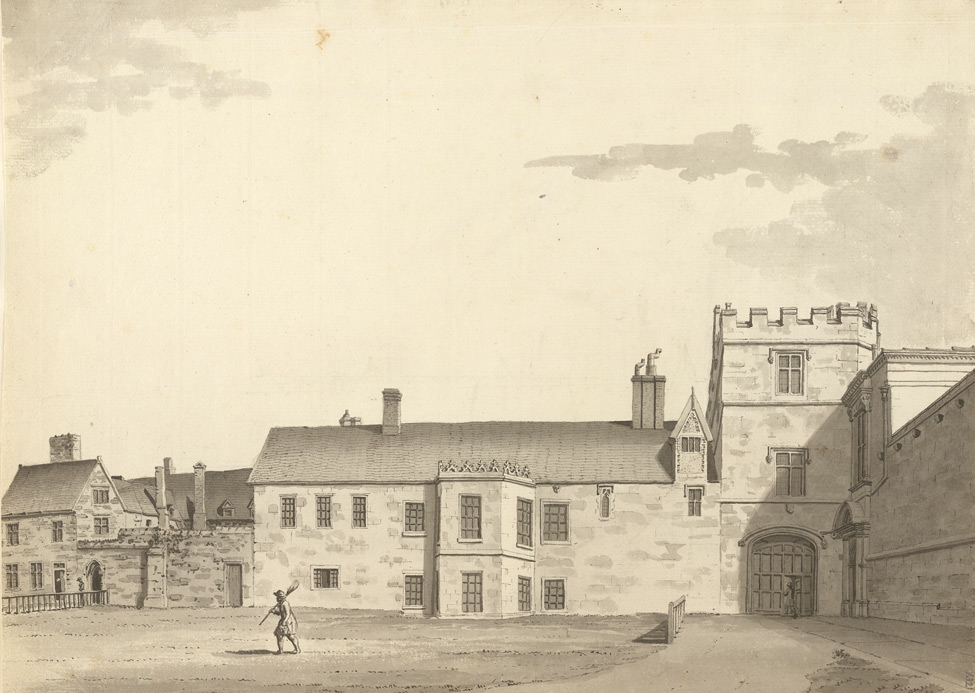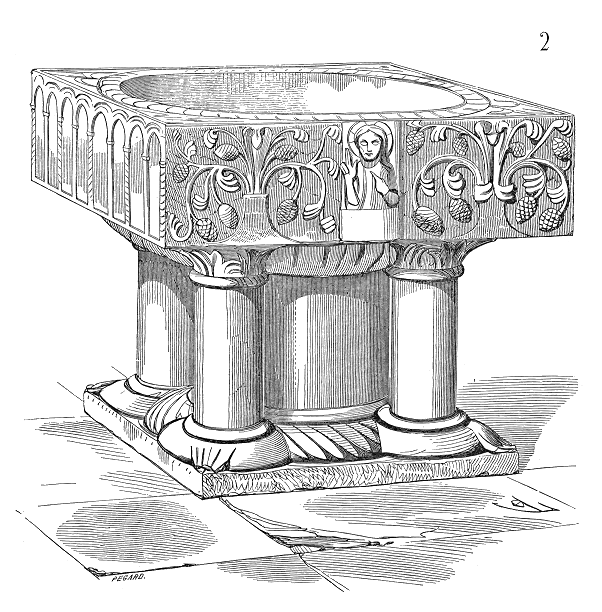|
Ledger Stone
A ledger stone or ledgerstone is an inscribed stone slab usually laid into the floor of a church to commemorate or mark the place of the burial of an important deceased person. The term "ledger" derives from the Middle English words ''lygger'', ''ligger'' or ''leger'', themselves derived from the root of the Old English verb ''liċġan'', meaning to lie (down). Ledger stones may also be found as slabs forming the tops of tomb chest monuments. Form and geology Ledger stones take the form of an inscribed stone slab, usually laid into the floor of a church to commemorate or mark the place of the burial of an important deceased person. Ledger stones may also be found as slabs forming the tops of chest tombs. An inscription is usually incised into the stone within a ledger line running around the edge of the stone. Such inscription may continue within the central area of the stone, which may be decorated with Relief sculpture, relief-sculpted or incised coats of arms, or other appropria ... [...More Info...] [...Related Items...] OR: [Wikipedia] [Google] [Baidu] [Amazon] |
Holy Trinity Church, Hull
Hull Minster is the Anglican minster and the parish church of Kingston upon Hull in the East Riding of Yorkshire, England. The church was called Holy Trinity Church until 13 May 2017 when it became Hull Minster. History The transepts date from , the choir is estimated at 1340–70, the nave 1380–1420 and the tower 1490–1520. In the early to mid 18th century, the brickwork of the choir and transepts was covered with stucco, later removed in a restoration of the church by Henry Francis Lockwood between 1842-45. During this restoration the galleries and pews were removed. The stonework was cleaned of paint. The nave was fitted with oak stalls enriched with poppy heads, carved by George Peck of Hull. Many of the poppy heads were executed from casts of existing models in Lincoln Cathedral. Central heating consisting of iron pipework was installed in the nave by Mr. Reid of Hull. The ceiling was decorated mainly in ultra-marine blue, with beams picked out in Crimson and gold. ... [...More Info...] [...Related Items...] OR: [Wikipedia] [Google] [Baidu] [Amazon] |
Sussex Marble
Sussex Marble is a fossiliferous freshwater limestone material which is prevalent in the Weald Clay of parts of Kent, East Sussex and West Sussex in southeast England. It is also called Petworth Marble, Bethersden Marble or Laughton Stone in relation to villages where it was quarried, and another alternative name is winklestone. It is referred to as "marble" as it polishes very well, although it is not a true marble, geologically speaking, as it has not been subject to metamorphism. The matrix is made up of the shells of freshwater gastropods and '' viviparus'' winkles, similar to but larger than those making Purbeck Marble. The pale calcified remains of the shells are in a matrix of darker material. West Sussex has a good concentration of thin layers of Sussex Marble; beds typically measure no more than thick. There are often two beds—the lower formed of smaller-shelled gastropods than the upper—with a layer of calcareous clay between them. Historical use The Weald of ... [...More Info...] [...Related Items...] OR: [Wikipedia] [Google] [Baidu] [Amazon] |
Nijmegen
Nijmegen ( , ; Nijmeegs: ) is the largest city in the Dutch province of Gelderland and the ninth largest of the Netherlands as a whole. Located on the Waal River close to the German border, Nijmegen is one of the oldest cities in the Netherlands and the first to be recognized as such in Roman times. In 2005, it celebrated 2,000 years of existence. Nijmegen became a free imperial city in 1230 and in 1402 a Hanseatic city. Since 1923 it has been a university city with the opening of a Catholic institution now known as the Radboud University Nijmegen. The city is well known for the annual International Four Days Marches Nijmegen event. Its population as of 2024 was 187,011. Population centres The municipality is formed by the city of Nijmegen, incorporating the former villages of Hatert, Hees and Neerbosch, as well as the urban expansion projects in Veur-Lent, Nijmegen-Oosterhout and Nijmegen–Ressen, all situated north of the river Waal. Proximity of border ... [...More Info...] [...Related Items...] OR: [Wikipedia] [Google] [Baidu] [Amazon] |
Haarlem
Haarlem (; predecessor of ''Harlem'' in English language, English) is a List of cities in the Netherlands by province, city and Municipalities of the Netherlands, municipality in the Netherlands. It is the capital of the Provinces of the Netherlands, province of North Holland. Haarlem is situated at the northern edge of the Randstad, one of the Largest European cities and metropolitan areas, more populated metropolitan areas in Europe; it is also part of the Amsterdam metropolitan area. Haarlem had a population of in . Haarlem was granted city status or in 1245, although the first city walls were not built until 1270. The modern city encompasses the former municipality of Schoten, Netherlands, Schoten as well as parts that previously belonged to Bloemendaal and Heemstede. Apart from the city, the municipality of Haarlem also includes the western part of the village of Spaarndam. Newer sections of Spaarndam lie within the neighbouring municipality of Haarlemmermeer. Geography ... [...More Info...] [...Related Items...] OR: [Wikipedia] [Google] [Baidu] [Amazon] |
Sir Richard Kaye, 6th Baronet
Sir Richard Kaye, 6th Baronet, , LL.D (1736–25 December 1809) was an English peer, churchman and scientist. He was Dean of Lincoln from 1783, and inherited the baronetcy from his elder brother Sir John Lister Kaye, 5th Baronet in 1789. Life He was educated at Brasenose College, Oxford graduating BCL in 1761. He was a patron of the artists Samuel Hieronymus Grimm, whom he commissioned for two decades to draw "everything curious", and Tilly Kettle. He was a friend of Joseph Banks whom he proposed for the Royal Society, and also Captain James Cook: Cook named after him the island now called Kayak Island. He was a member of the Madrigal Society, and also a Trustee of the British Museum. He married Ellen Fenton, daughter of William Fenton of Rothwell, West Yorkshire and widow of Thomas Mainwaring. In 1789 he was to inherit a baronetcy. He left no children, and the baronetcy came to an end with him. Clerical career Kaye was noted both for his piety but also as a great pluralist ... [...More Info...] [...Related Items...] OR: [Wikipedia] [Google] [Baidu] [Amazon] |
Mazy
Mazy (; ) is a village of Wallonia and a district of the municipality of Gembloux, located in the province of Namur, Belgium. Geography Mazy is crossed by the Orneau (a tributary of the Sambre). Heritage Falnuée Castle Falnuée Castle ( is a ''château-ferme'' (castle farm) in Mazy, in the municipality of Gembloux, province of Namur, Wallonia, Belgium. It is now a golf clubhouse. See also *List of castles in Belgium A list is a set of discrete items of i ..., currently a golf clubhouse, is located in Mazy. References External links * — picture of the castle. Former municipalities of Namur (province) Gembloux {{Namur-geo-stub ... [...More Info...] [...Related Items...] OR: [Wikipedia] [Google] [Baidu] [Amazon] |
Golzinne
Golzinne () is a hamlet of the village of Bossière in Wallonia. It is administratively part of the city of Gembloux, located in the province of Namur, Belgium. It is notable as the only current producer of " Noir de Golzinne", a black marble. Marble from Golzinne was used in decorations of the Palace of Versailles The Palace of Versailles ( ; ) is a former royal residence commissioned by King Louis XIV located in Versailles, Yvelines, Versailles, about west of Paris, in the Yvelines, Yvelines Department of Île-de-France, Île-de-France region in Franc .... See also * Noir Belge Populated places in Namur (province) Gembloux {{Namur-geo-stub ... [...More Info...] [...Related Items...] OR: [Wikipedia] [Google] [Baidu] [Amazon] |
Tournai Font
Tournai fonts are a type of baptismal font made from blue black limestone during the 12th and early 13th centuries in and around the Belgian town of Tournai by local masons. There are seven complete examples in England and a disputed number in Europe: eighty according to one source, or fifty in Northern France and Belgium and two in Germany according to another. A sculptural tradition, centred around Tournai, arose in the Scheldt valley from the 11th century onwards. This was characterised by its use of low relief (which was a useful feature when a sculpture was transported), hard lines and the depiction of minute detail, these features arising from the hardness of the material used from the 12th century; Tournai marble. As a sculptural style it is distinguished from the contemporary style of Mosan art, and it was used in sculpture in both Ghent and Bruges. The designation "Tournai font" is employed to identify fonts made by local masons who worked the stone, as opposed to at le ... [...More Info...] [...Related Items...] OR: [Wikipedia] [Google] [Baidu] [Amazon] |
Romanesque Architecture
Romanesque architecture is an architectural style of medieval Europe that was predominant in the 11th and 12th centuries. The style eventually developed into the Gothic style with the shape of the arches providing a simple distinction: the Romanesque is characterized by semicircular arches, while the Gothic is marked by the pointed arches. The Romanesque emerged nearly simultaneously in multiple countries of Western Europe; its examples can be found across the continent, making it the first pan-European architectural style since Imperial Roman architecture. Similarly to Gothic, the name of the style was transferred onto the contemporary Romanesque art. Combining features of ancient Roman and Byzantine buildings and other local traditions, Romanesque architecture is known by its massive quality, thick walls, round arches, sturdy pillars, barrel vaults, large towers and decorative arcading. Each building has clearly defined forms, frequently of very regular, symmetrical ... [...More Info...] [...Related Items...] OR: [Wikipedia] [Google] [Baidu] [Amazon] |
Tournaisian
The Tournaisian is in the ICS geologic timescale the lowest stage or oldest age of the Mississippian, the oldest subsystem of the Carboniferous. The Tournaisian age lasted from Ma to Ma. It is preceded by the Famennian (the uppermost stage of the Devonian) and is followed by the Viséan. In global stratigraphy, the Tournaisian contains two substages: the Hastarian (lower Tournaisian) and Ivorian (upper Tournaisian). These two substages were originally designated as European regional stages. Name and regional alternatives The Tournaisian was named after the Belgian city of Tournai. It was introduced in scientific literature by Belgian geologist André Hubert Dumont in 1832. Like many Devonian and lower Carboniferous stages, the Tournaisian is a unit from West European regional stratigraphy that is now used in the official international time scale. The Tournaisian correlates with the regional North American Kinderhookian and lower Osagean stages and the Chinese Tan ... [...More Info...] [...Related Items...] OR: [Wikipedia] [Google] [Baidu] [Amazon] |
Carboniferous Period
The Carboniferous ( ) is a geologic period and system of the Paleozoic era that spans 60 million years, from the end of the Devonian Period Ma (million years ago) to the beginning of the Permian Period, Ma. It is the fifth and penultimate period of the Paleozoic era and the fifth period of the Phanerozoic eon. In North America, the Carboniferous is often treated as two separate geological periods, the earlier Mississippian and the later Pennsylvanian. The name ''Carboniferous'' means "coal-bearing", from the Latin ("coal") and ("bear, carry"), and refers to the many coal beds formed globally during that time. The first of the modern "system" names, it was coined by geologists William Conybeare and William Phillips in 1822, based on a study of the British rock succession. Carboniferous is the period during which both terrestrial animal and land plant life was well established. Stegocephalia (four-limbed vertebrates including true tetrapods), whose forerunners (tetrapodomo ... [...More Info...] [...Related Items...] OR: [Wikipedia] [Google] [Baidu] [Amazon] |





